私立华联学院:《英语国家概况》课程教学资源(试卷习题)USA 4
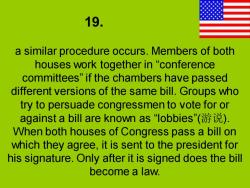
a similar procedure occurs.Members of both houses work together in "conference committees"if the chambers have passed different versions of the same bill.Groups who try to persuade congressmen to vote for or against a bill are known as“"lobbies"(游说). When both houses of Congress pass a bill on which they agree,it is sent to the president for his signature.Only after it is signed does the bill become a law
19. a similar procedure occurs. Members of both houses work together in “conference committees” if the chambers have passed different versions of the same bill. Groups who try to persuade congressmen to vote for or against a bill are known as “lobbies”(游说). When both houses of Congress pass a bill on which they agree, it is sent to the president for his signature. Only after it is signed does the bill become a law
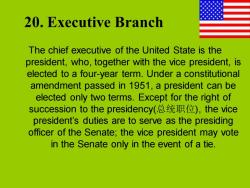
20.Executive Branch The chief executive of the United State is the president,who,together with the vice president,is elected to a four-year term.Under a constitutional amendment passed in 1951,a president can be elected only two terms.Except for the right of succession to the presidency(总统职位),the vice president's duties are to serve as the presiding officer of the Senate;the vice president may vote in the Senate only in the event of a tie
20. Executive Branch The chief executive of the United State is the president, who, together with the vice president, is elected to a four-year term. Under a constitutional amendment passed in 1951, a president can be elected only two terms. Except for the right of succession to the presidency(总统职位), the vice president’s duties are to serve as the presiding officer of the Senate; the vice president may vote in the Senate only in the event of a tie
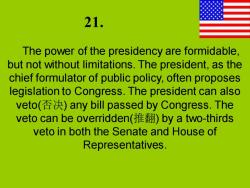
21. The power of the presidency are formidable, but not without limitations.The president,as the chief formulator of public policy,often proposes legislation to Congress.The president can also veto(否决)any bill passed by Congress.The veto can be overridden(推翻)by a two--thirds veto in both the Senate and House of Representatives
21. The power of the presidency are formidable, but not without limitations. The president, as the chief formulator of public policy, often proposes legislation to Congress. The president can also veto(否决) any bill passed by Congress. The veto can be overridden(推翻) by a two-thirds veto in both the Senate and House of Representatives
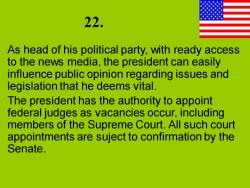
22. As head of his political party,with ready access to the news media,the president can easily influence public opinion regarding issues and legislation that he deems vital. The president has the authority to appoint federal judges as vacancies occur,including members of the Supreme Court.All such court appointments are suject to confirmation by the Senate
22. As head of his political party, with ready access to the news media, the president can easily influence public opinion regarding issues and legislation that he deems vital. The president has the authority to appoint federal judges as vacancies occur, including members of the Supreme Court. All such court appointments are suject to confirmation by the Senate
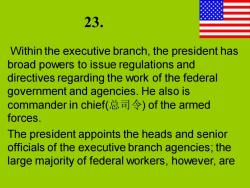
23. Within the executive branch,the president has broad powers to issue regulations and directives regarding the work of the federal government and agencies.He also is commander in chief(总司令)of the armed forces. The president appoints the heads and senior officials of the executive branch agencies;the large majority of federal workers,however,are
23. Within the executive branch, the president has broad powers to issue regulations and directives regarding the work of the federal government and agencies. He also is commander in chief(总司令) of the armed forces. The president appoints the heads and senior officials of the executive branch agencies; the large majority of federal workers, however, are
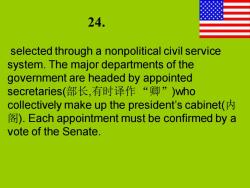
24. selected through a nonpolitical civil service system.The major departments of the government are headed by appointed secretaries(部长,有时译作“卿”)who collectively make up the president's cabinet( )Each appointment must be confirmed by a vote of the Senate
24. selected through a nonpolitical civil service system. The major departments of the government are headed by appointed secretaries(部长,有时译作 “卿”)who collectively make up the president’s cabinet(内 阁). Each appointment must be confirmed by a vote of the Senate
按次数下载不扣除下载券;
注册用户24小时内重复下载只扣除一次;
顺序:VIP每日次数-->可用次数-->下载券;
- 私立华联学院:《英语国家概况》课程教学资源(试卷习题)USA 3.ppt
- 私立华联学院:《英语国家概况》课程教学资源(试卷习题)USA 2.ppt
- 私立华联学院:《英语国家概况》课程教学资源(试卷习题)USA 1.ppt
- 私立华联学院:《英语国家概况》课程教学资源(试卷习题)the UK 9.ppt
- 私立华联学院:《英语国家概况》课程教学资源(试卷习题)the UK 8.ppt
- 私立华联学院:《英语国家概况》课程教学资源(试卷习题)the UK 7.ppt
- 私立华联学院:《英语国家概况》课程教学资源(试卷习题)the UK 6.ppt
- 私立华联学院:《英语国家概况》课程教学资源(试卷习题)the UK 5.ppt
- 私立华联学院:《英语国家概况》课程教学资源(试卷习题)the UK 4.ppt
- 私立华联学院:《英语国家概况》课程教学资源(试卷习题)the UK 3.ppt
- 私立华联学院:《英语国家概况》课程教学资源(试卷习题)the UK 2.ppt
- 私立华联学院:《英语国家概况》课程教学资源(试卷习题)the UK 11.ppt
- 私立华联学院:《英语国家概况》课程教学资源(试卷习题)the UK 10.ppt
- 私立华联学院:《英语国家概况》课程教学资源(试卷习题)the UK 1.ppt
- 私立华联学院:《英语国家概况》课程教学资源(PPT课件)Unit 8 Holidays and Festivals.ppt
- 私立华联学院:《英语国家概况》课程教学资源(PPT课件)Unit 6 Etiquette and Manners.ppt
- 私立华联学院:《英语国家概况》课程教学资源(PPT课件)Unit 9 Tourist Attraction.ppt
- 私立华联学院:《英语国家概况》课程教学资源(PPT课件)Unit 7 Ways of Living.ppt
- 私立华联学院:《英语国家概况》课程教学资源(PPT课件)Unit 5 Popular Culture.ppt
- 私立华联学院:《英语国家概况》课程教学资源(PPT课件)Unit 4 Education.ppt
- 私立华联学院:《英语国家概况》课程教学资源(试卷习题)USA 5.ppt
- 私立华联学院:《英语国家概况》课程教学资源(试卷习题)USA 6.ppt
- 私立华联学院:《英语国家概况》课程教学资源(试卷习题)USA 7.ppt
- 私立华联学院:《英语国家概况》课程教学资源(试卷习题)USA 8.ppt
- 私立华联学院:《英语国家概况》课程教学资源(试卷习题)USA 9.ppt
- 私立华联学院:《英语国家概况》课程教学资源(PPT课件)Chapter One The United Kingdom of Great Britain and Northern Ireland.pptx
- 私立华联学院:《英语国家概况》课程教学资源(PPT课件)Chapter Two The United States of America.pptx
- 私立华联学院:《英语国家概况》课程教学资源(PPT课件)Chapter Three Canada.pptx
- 私立华联学院:《英语国家概况》课程教学资源(PPT课件)Chapter Four Australia.pptx
- 私立华联学院:《英语国家概况》课程教学资源(PPT课件)Chapter Five New Zealand.pptx
- 《英语国家社会与文化入门》课程PPT教学课件(上册)The Society and Culture of Major English-Speaking Countries An Introduction Book 1 Unit 01 A Brief Introduction to the United Kingdom Ⅰ.ppt
- 《英语国家社会与文化入门》课程PPT教学课件(上册)The Society and Culture of Major English-Speaking Countries An Introduction Book 1 Unit 02 A Brief Introduction to the United Kingdom Ⅱ.pptx
- 《英语国家社会与文化入门》课程PPT教学课件(上册)The Society and Culture of Major English-Speaking Countries An Introduction Book 1 Unit 03 The Government of the United Kingdom.pptx
- 《英语国家社会与文化入门》课程PPT教学课件(上册)The Society and Culture of Major English-Speaking Countries An Introduction Book 1 Unit 04 Politics, Class and Race.ppt
- 《英语国家社会与文化入门》课程PPT教学课件(上册)The Society and Culture of Major English-Speaking Countries An Introduction Book 1 Unit 05 The UK Economy.ppt
- 《英语国家社会与文化入门》课程PPT教学课件(上册)The Society and Culture of Major English-Speaking Countries An Introduction Book 1 Unit 06 British Literature.pptx
- 《英语国家社会与文化入门》课程PPT教学课件(上册)The Society and Culture of Major English-Speaking Countries An Introduction Book 1 Unit 07 British Education System.ppt
- 《英语国家社会与文化入门》课程PPT教学课件(上册)The Society and Culture of Major English-Speaking Countries An Introduction Book 1 Unit 08 British Foreign Relations.ppt
- 《英语国家社会与文化入门》课程PPT教学课件(上册)The Society and Culture of Major English-Speaking Countries An Introduction Book 1 Unit 09 The British Media.pptx
- 《英语国家社会与文化入门》课程PPT教学课件(上册)The Society and Culture of Major English-Speaking Countries An Introduction Book 1 Unit 10 Sports, Holidays and Festivals in Britain.pptx
